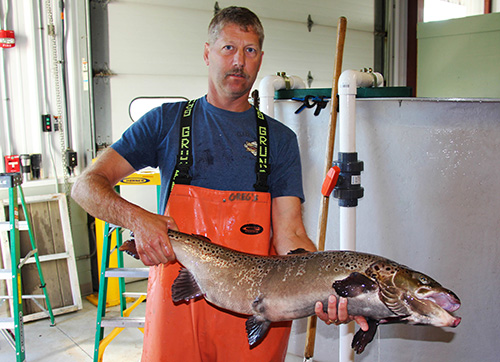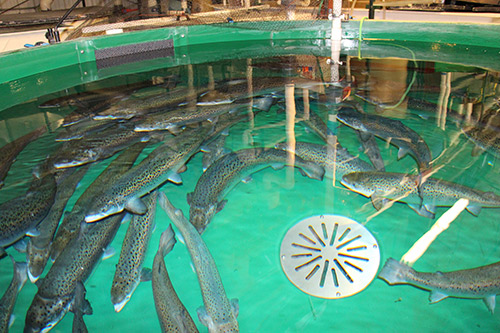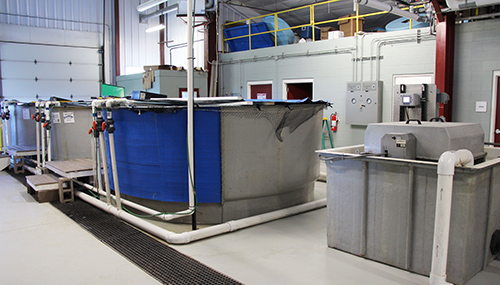Recirculating Aquaculture System Technology
The majority of the Atlantic salmon sold in the U.S. is imported from other countries and farmed by net pen aquaculture. Net pen aquaculture is found offshore in coastal areas or in freshwater lakes, open-net pens, or ‘cages”. There are several concerns with utilizing net pen aquaculture which include disease transfer, escapement, and detrimental environmental effects. For this reason, land-based, closed-containment systems are looking to be a viable option for sustainably and safely raising Atlantic salmon.

Greg Fischer (Facility Operations Manager) with Atlantic Salmon.
At the University of Wisconsin-Stevens Point Northern Aquaculture Demonstration Facility (UWSP NADF), a specific strain of Atlantic salmon is being researched to determine the success of raising them in closed containment systems. The UWSP NADF’s mission is to conduct research on sustainable aquaculture in northern climates and to share this knowledge through public education. This is done by conducting applied research, providing training and workshops and educational opportunities, and developing best management practices for the sustainable and environmental aquaculture industry. Currently, the facility is working collaboratively with a private company to explore the development of an Atlantic salmon broodstock and the progeny for possible future use in food-fish aquaculture.

The goal of this project is to provide eggs to Wisconsin fish farmers to raise Atlantic salmon sustainably for distribution to the food market.
The strain of Atlantic salmon at UWSP-NADF, known as the Cascade strain, has shown tremendous potential for the future in sustainable land-based aquaculture systems. The broodstock are just over 4 years old and are reaching weights of 40 pounds. The cascade brood was brought to the facility as one-year-olds and raised in a partial recirculating aquaculture system utilizing a drum filter, UV sterilization and Cornell-style dual drain, round fiberglass tanks. The system consists of three 12 foot diameter tanks, adding up to a total culture space of 36,138 L (36.1M3). The system is utilizing a total of 230 gallons per minute of recirculation water with around 60 gallons per minute of fresh water.
The facility is a Recirculating Aquaculture System (RAS) in which aquatic organisms are raised in filtered, reused water.
This type of system:
• Conserves water
• Allows for high-density culture in small spaces
• Minimizes volume of effluent
• Allows for increased control over the environment
• Environmentally sustainable
The health of these fish is crucial for both the project as well as the continuation of this strain as a food fish species. Each tank is closely monitored, which includes a full water quality analysis daily. The water quality conditions are typically high in suspended and dissolved solids, high ammonia levels, and low dissolved oxygen.

The University of Wisconsin Stevens Point Northern Aquaculture Demonstration Facility.
The facility uses a continuous monitor, the YSI 5500D, an optical dissolved oxygen instrument. It is used to monitor temperature and oxygen continuously in all three tanks. This monitoring system will be wired into the facility’s SCADA system via YSI’s IOEM expansion module (4-20 mA output) to document, measure, and monitor parameters automatically.
These parameters, as well as flow rates and pump operation, will be backed up to the SCADA system to monitor and send alarm notifications. This will help staff monitor the conditions and be alerted if anything falls outside of the setpoints.
Acknowledgments: Many thanks to Greg Fischer and Emma Wiermaa at UWSP-NADF for sharing this story and for their contributions to Aquaculture research.

Additional Blog Posts of Interest
Newport Aquarium's Rare Sharks Benefit from Continuous Monitoring
Automation Fine-Tunes Aquaculture Production Efficiency and Increases Profits
Aquaculture Raceway Shrimp Production with Dissolved Oxygen Monitoring
Improve Efficiency with Aquaculture Monitoring & Control Technology